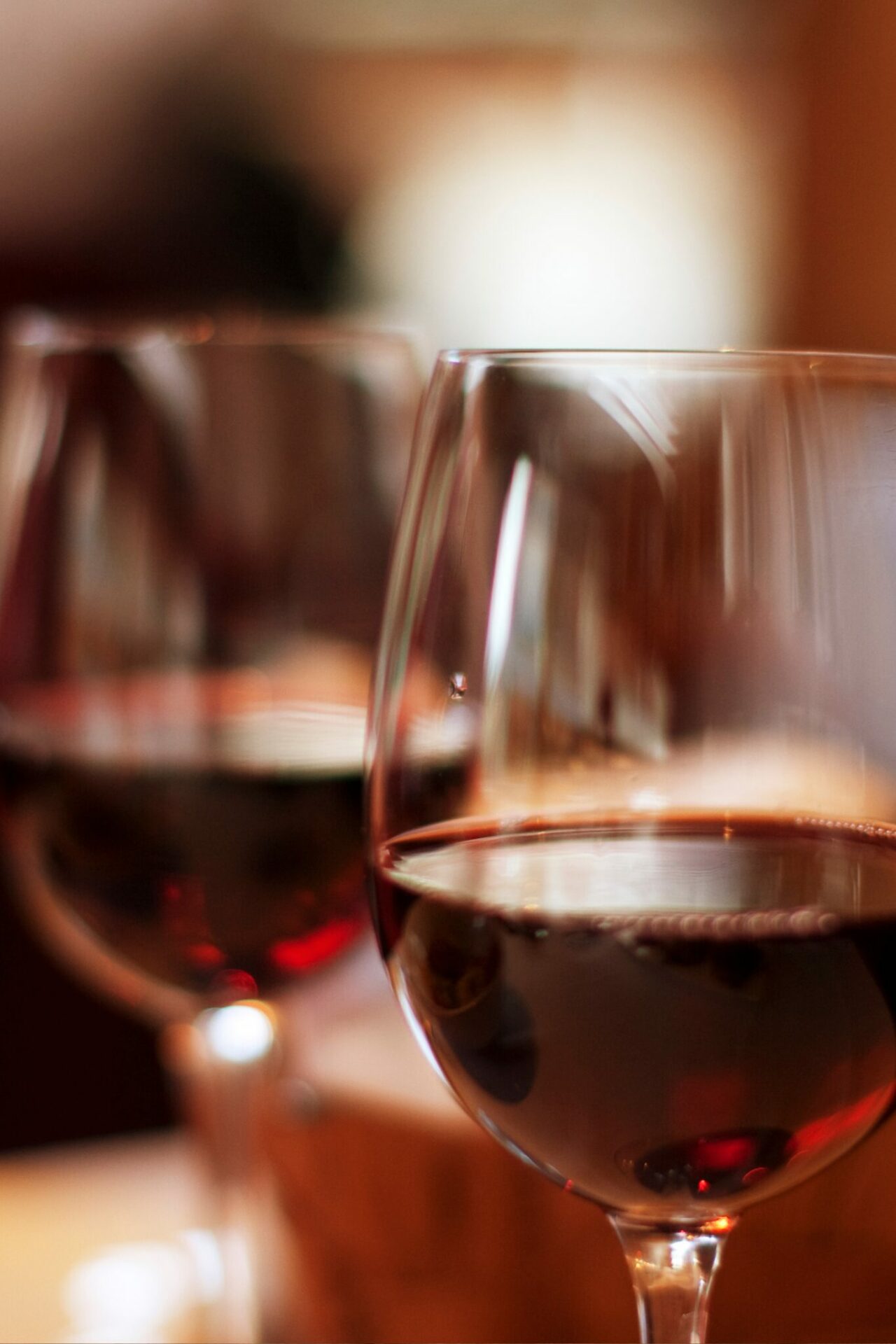
The first time I heard about Brunello di Montalcino, I was at a cozy wine shop in my neighborhood, surrounded by friends and laughter. We struck up a conversation with the owner, who shared stories about a special trip to Italy, where he visited the rolling hills of Montalcino.
From him, I learned of some of the most exquisite wines, like the Sangiovese Grosso grapes used to make Brunello Montalcino wine. I was captivated not just by the wine, but by the rich history behind it. I loved hearing about how this gem became Italy’s first DOCG wine.
Needless to say, Brunello di Montalcino is now one of my favorite red wines ever! Every sip makes me feel like I’m a part of something special, something that connected generations of winemakers to their craft.
In this article, you’ll learn all about Brunello di Montalcino. You’ll read of its unique terroir, its fascinating winemaking process, and the exceptional qualities that make it a favorite among wine lovers.
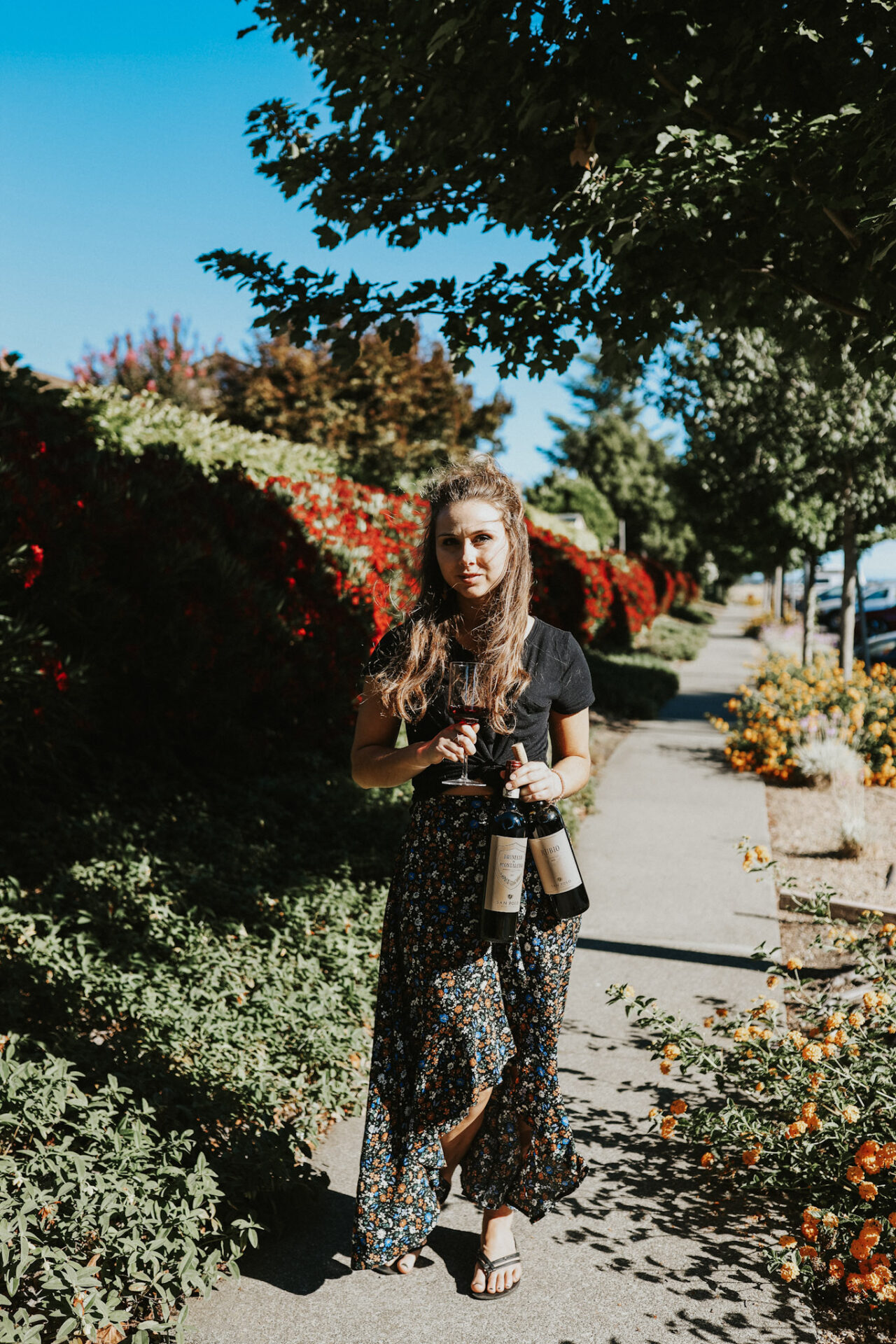
What Exactly Is Brunello di Montalcino?
Brunello di Montalcino is a red wine made exclusively from the Sangiovese Grosso grape, a variety known for its bold character and depth. It is one of Italy’s most prestigious wines, with its rich flavors and excellent aging potential.
Brunello di Montalcino holds the prestigious DOCG status, which stands for Denominazione di Origine Controllata e Garantita. Having this status means the wine meets strict quality standards.
The wine’s journey to fame started in the 1800s with a local winemaker named Ferruccio Biondi-Santi. His dedication to quality and traditional methods helped put Brunello on the map.
By the mid-20th century, Brunello di Montalcino gained recognition internationally and is now a symbol of Italian winemaking excellence.
It is important to note that Brunello di Montalcano might be wrongly referred to as Brunello Montepulciano. However, Brunello di Montepulciano doesn’t exist. People often get confused because of the similar names between Brunello di Montalcino and Vino Nobile di Montepulciano, which is a different wine.
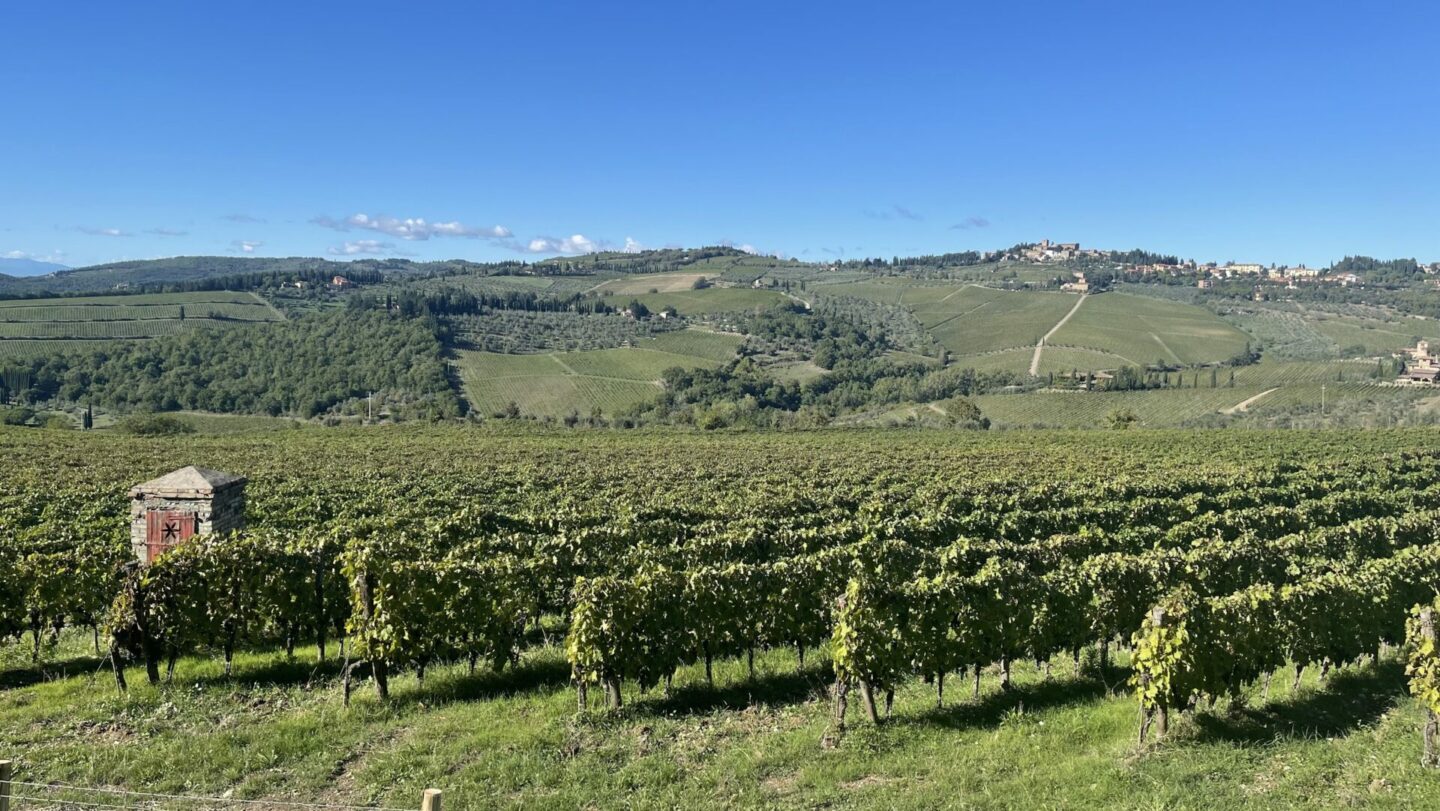
The Terroir of Montalcino
The Brunello di Montalcino region in Tuscany is famous for producing the Brunello di Montalcino grape, also called Sangiovese grape. The climate is warm and sunny, which helps the grapes ripen perfectly. The Brunello wine region has soil that is made up of mostly clay and limestone, which gives the wine its unique flavors.
The elevation of the vineyards at the Brunello region Italy, ranges from about 120 to 650 meters, and that affects how much sunlight and cool air the grapes receive. This mix of climate, soil, and height makes it perfect for growing top-quality Sangiovese Grosso grapes
Winemaking
The winemaking process for Brunello di Montalcino combines traditional techniques with modern innovations. After harvesting, each Brunello grape is carefully sorted before fermentation begins.
Winemakers usually use large oak barrels for fermentation. This allows the wine to develop complex flavors while maintaining its fruitiness. Some producers may use smaller French barrels to add unique flavors.
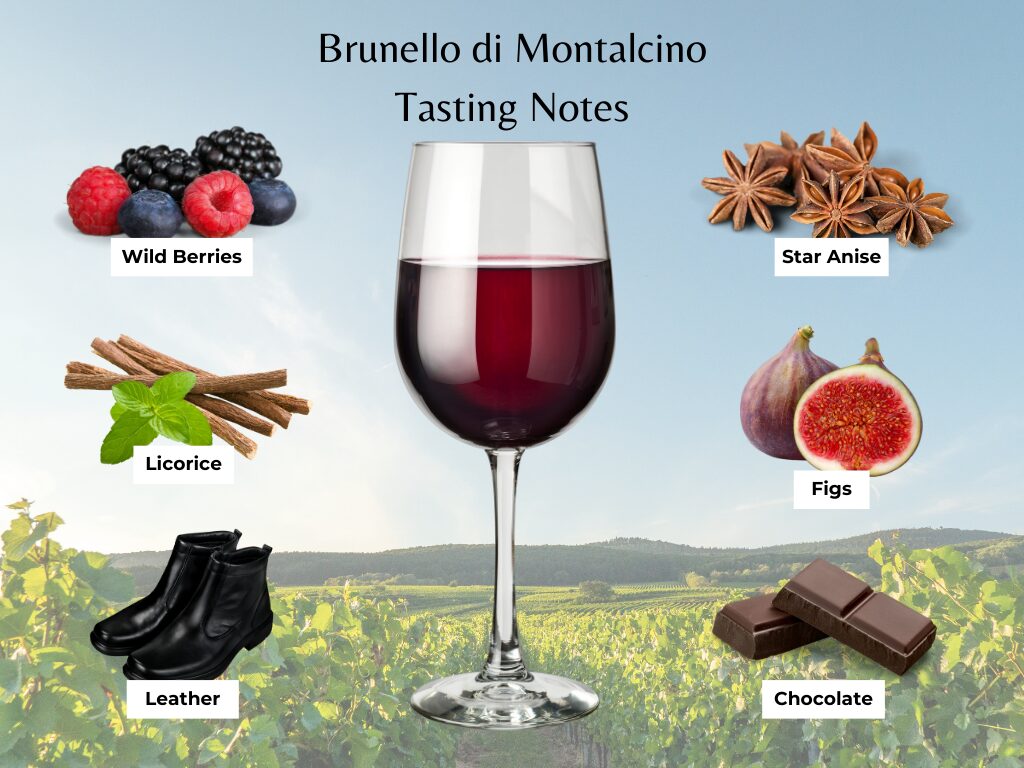
What does Brunello Taste Like?
Brunello di Montalcino, Italy, is known for its bold flavors and impressive structure. When you take a sip, you’ll notice an array of aromas that make this wine truly special.
Tasting Notes of Brunello di Montalcino DOCG
Brunello di Montalcino has complex tasting notes of wild berries, licorice, leather, and star anise when young, with strong tannins and acidity. As it ages, Brunello red wine develops deeper flavors of dried figs, candied cherries, hazelnuts, and chocolate, with smoother textures
Structure
This wine is full-bodied with high tannins and balanced acidity. The robust structure makes it an excellent candidate for aging; many enthusiasts enjoy cellaring their bottles for years to unlock even more depth.
Brunello Aging Requirements
Brunello di Montalcino wine should be aged for at least five years. It has remarkable aging potential; some bottles can evolve beautifully over 10-20 years or more. As the wine ages, expect richer flavors to emerge along with greater complexity—a true testament to its quality.
Food Pairing with Brunello di Montalcino
The wine’s high tannins and acidity make it an excellent match for hearty dishes. Aim for foods that can stand up to its intensity without being overshadowed. These are some ideal food pairing suggestions that go well with Brunello di Montalcino wine:
Bistecca alla Fiorentina: This classic Tuscan steak dish pairs beautifully with Brunello’s bold flavors.
Wild Game: Dishes featuring game meats like venison or wild boar complement Brunello’s earthy notes.
Aged Cheeses: Hard cheeses such as Parmigiano-Reggiano or Pecorino go well with the wine’s complexity.
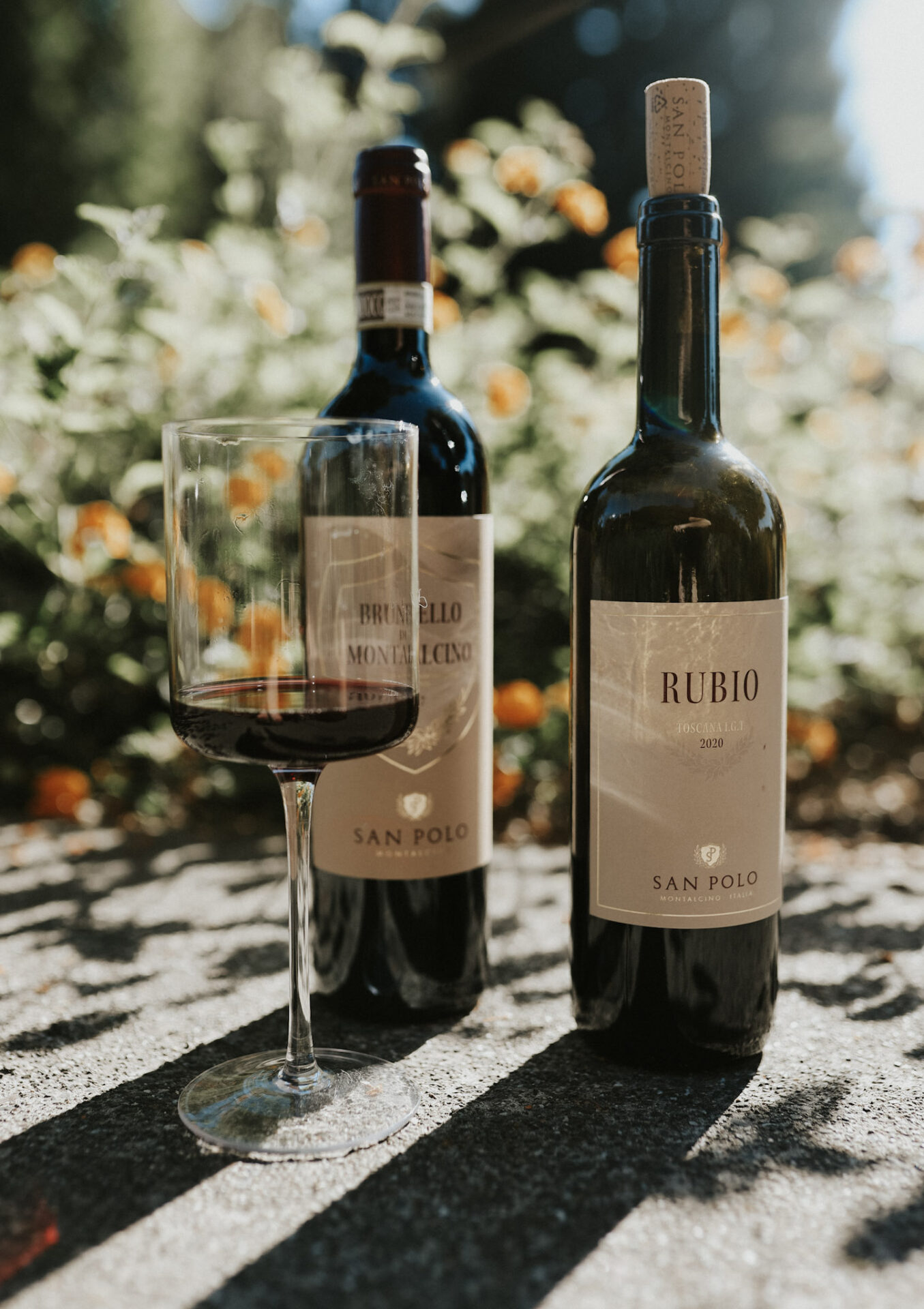
How to Choose and Buy Brunello di Montalcino
These are some things to look out for when selecting the best Brunello wine:
- Producer Reputation: Consider producers like Biondi-Santi or Casanova di Neri, as they are known for consistent quality.
- DOCG (Denominazione di Origine Controllata e Garantita): is the highest classification of Italian wines. This label shows the wine has not only met the standards of DOC but has been thoroughly tested and tasted to ensure quality.
- Brunello di Montalcino Price Points: Brunello wine price can vary widely based on producer and vintage. You can find good options starting around $40, while top rated Brunello wines may reach $200 or more.
Check local wine shops or reputable online retailers for a Brunello price range that fits your budget.
Serving and Storing Brunello di Montalcino
Properly store and serve Brunello wine to enjoy it at its best. To fully appreciate Brunello:
Decant: Allowing the wine to breathe enhances its aromas and flavors. To decant wine, first let the bottle stand upright for about 24 hours to allow sediment to settle. Then gently pour the wine into a decanter, stopping before the sediment reaches the neck of the bottle. Allow the wine to breathe for about 20 minutes, then serve.
Glassware: To fully appreciate Brunello, Italy, use a large-bowled wine glass that narrows at the top, as this design enhances the wine’s rich tannins and complex fruit aromas.
Temperature: Serve at a temperature of around 18°C to 20°C (64°F to 68°F) to enhance its rich flavors and aromas.
How to Store Brunello for optimal aging:
- Store bottles upright in a cool, dark place with stable temperatures.
- Don’t expose it to light or vibrations that could affect quality.
Many wines improve with a few years of aging before they are at their best for drinking. Keep track of your bottles’ age and plan tastings accordingly.
Conclusion
Brunello di Montalcino is celebrated as one of Italy’s finest wines. With its unique terroir, careful winemaking process, and impressive aging ability, it’s no wonder this Tuscan classic has captured the hearts of wine lovers worldwide.
Whether you’re enjoying it now or saving it for a special occasion, Brunello promises a memorable experience that celebrates the beauty of Italian winemaking.
Frequently Asked Questions
What grape is used in Brunello di Montalcino?
Brunello di Montalcino is made exclusively from 100% Sangiovese grapes.
How long should Brunello di Montalcino be aged before drinking?
Brunello must be aged for at least 5 years, with 2 years in oak barrels and 4 months in the bottle. Riserva requires it be aged at least 6 years.
What is the alcohol content of Brunello di Montalcino?
The minimum alcohol content for Brunello di Montalcino is typically 12.5% ABV.
